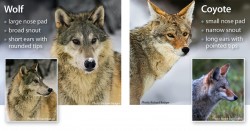Wolf enthusiasts take note. A researcher at the University of Helsinki just released an analysis of wolf depredation in North America and Europe. Researcher Linda Kartano’s report is accompanied by this extract:
“Conflicts are concern for the coexistence of wolves (Canis lupus) and humans, and injuries and deaths of domestic animals (i.e. depredations) are a concrete part of the conflicts. Even though wildlife researchers have studied characteristics, risk factors, and prevention methods of depredation for decades, the diversity and complexity of depredation phenomenon has ensured that there is still a long way to go before the knowledge and management of depredations reach a satisfactory level.
The thesis is consisted of three parts that have a broader theme in the description of the depredation phenomenon from slightly different perspectives and so to serve the purpose of increasing the capacity of understanding and managing the depredation.
The first part of the thesis gives a literature-based introduction to the problem of depredation and the factors that are likely to contribute to the depredation risk in general. The aim of the first part was to provide a foundation for the second and third parts. The second part of the thesis focuses on the large-scale depredation characteristics by surveying depredation records of Europe and North America via a literature review and personal data requests. The aims of the second part were to generalize the depredation characteristics on the large scale, to compare depredation datasets between study areas, and to study the relationship between depredations and possible large-scale explanatory factors of depredation. The third part of the thesis represents a collective study of wolf attacks on bear-hunting dogs in the states of Michigan and Wisconsin, US. The aim of the third part was to study the relationship between dog depredation rates and bear-hunting practices and to exemplify the benefits of the transregional research approach.
The second part of the thesis represented depredation characteristics from 20 study areas in Europe and the US. Small- or medium-sized domestic animals dominated the depredation records. The percentages of depredated livestock stayed small. Sheep and goat depredations occurred more often than expected and bovine and equine depredations less than expected by the occurrence of the animals in the live population. The second part showed also that despite the large variability between the depredation datasets, the composition and number of depredations were geographically clustered. Europe was defined by extensive sheep and goat depredations whereas the US was defined by moderate bovine depredations. The results also showed that wolf abundance and domestic animal densities correlated significantly with the number of depredations and depredation rates (depredations/wolf) whereas the human population density and the forest and farmland coverages correlated less significantly with the depredation rates. The third part of the thesis showed that the depredation rates of bear-hunting dogs in Michigan and Wisconsin are partly influenced by the bear-hunting permits sold per wolf and hunter method. The greater dog depredation rates in Wisconsin compared to Michigan could be affected by the longer duration of bear-baiting and more concurrent timing of baiting with dog training in Wisconsin. The differences in the compensation schemes could also contribute to the differences in depredation rates between the states. In conclusion, the results of the second part indicated that some characteristics of depredation that have been previously identified on the more local scales are applicable also on the large scales. More research is needed to clarify the role of wolf abundance and domestic animal densities in determining the depredation likelihood on the large scales. The depredation records were highly variable in relation to the data collection procedures, and it would be important to set minimum standards for the depredation data. The depredation research and management should be improved also by increasing the transparency and availability of depredation records. The third part of the thesis showed how the differences in natural resources management between the states might have a significant role in defining depredation rates for hunting dogs. The study exemplifies well how the depredation research and management can benefit from the collection and distribution of depredation data across the administrative borders. As the depredation information hopefully increases in the future, the large-scale picture of the depredation characteristics across Europe and North America will also be further defined.”
Check out the full report here: https://helda.helsinki.fi/handle/10138/158989